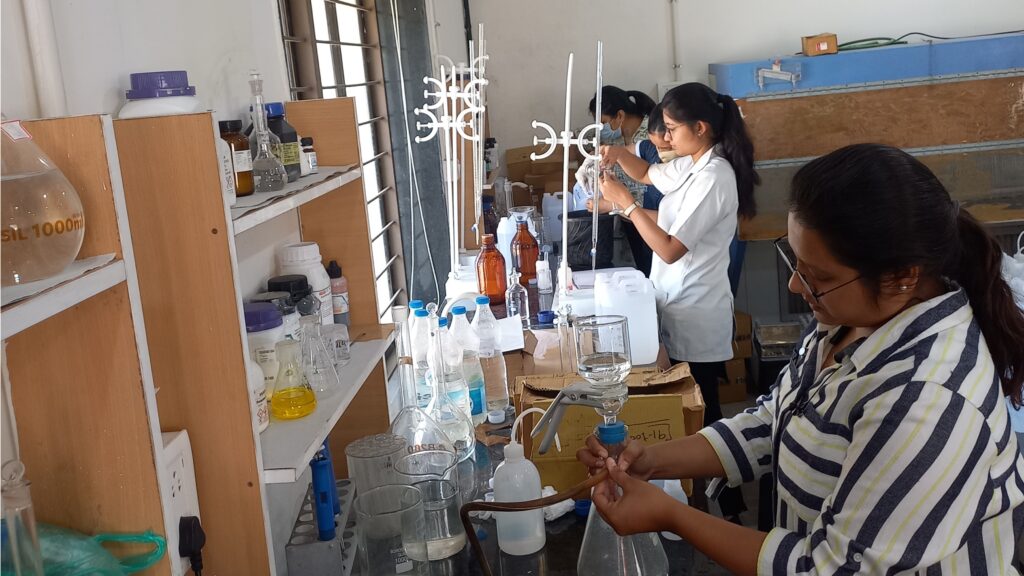
Welcome to the COMPETITIVE EXAM MCQs SERIES of ENVIRONMENTAL SCIENCE for UGC-NET/JRF, SLET, GATE, and other entrance tests. This quiz consists of 25 concept-based MCQs about chemical speciation, an important topic in environmental chemistry.
Syllabus outline
- Speciation of elements in different environmental compartments (e.g. air, water, Earth’s crust, soils and sediments.
- Speciation of air pollutants and role of chemical speciation in air quality assessment
- Chemical speciation of aerosols and particulate matter
- Complexation reactions in water and biogeochemical cycling
- Impact of chemical speciation on bioavailability and toxicity
- Speciation of organic compounds in different environmental compartments (e.g. air, water, Earth’s crust, soils and sediments.
- Role of organic speciation in environmental assessment
This quiz contains the concept-based most frequently asked 25 MCQs of Environmental Chemistry – Chemical Speciation. Each question has a single correct/most appropriate answer.
1. Which chemical speciation process is associated with the reaction of atmospheric pollutants with hydroxyl radicals (OH*)?
a) Hydrolysis
b) Photochemical degradation
c) Photodissociation
d) Volatilization
2. What role does organic complexation play in metal transformation such as mercury (Hg) in the atmosphere?
a) It binds them to aerosol particles, reducing their reactivity.
b) It accelerates their deposition to the Earth’s surface.
c) It does not influence the behaviour of mercury.
d) It enhances their volatility and atmospheric mobility.
3. Which organism is involved in the transformation from Nitrite to Nitrate?
a) Nitrobacter
b) Nitrosomonas
c) Rhizobium
d) Nitrobacillus
4. Which organic compounds are commonly found complexing with metal ions in the atmosphere due to their presence in natural and anthropogenic emissions?
a) Alkanes
b) Amino acids
c) Volatile organic compounds (VOCs)
d) Polycyclic aromatic hydrocarbons (PAHs)
5. How does coagulation contribute to removing particles from the atmosphere through chemical speciation?
a) It increases the solubility of aerosols.
b) It enhances the stability of aerosols.
c) It promotes the collision.
d) It encourages the formation of smaller particles.
6. Which atmospheric conditions can lead to increased metal deposition on surfaces?
a) Low temperatures and high wind speeds
b) Decreased atmospheric pressure
c) Clear skies and strong sunlight
d) High humidity and rainfall
7. Assertion (A): Denitrification is crucial for nitrogen chemical speciation in aquatic environments.
Reasoning (R): It involves the conversion of nitrate ions into nitrogen gas, reducing the nitrogen load in water bodies.
a) The A is false, but the R is true.
b) The A is true, but the R is false.
c) Both the A and R are true, and the R is a correct explanation of the A.
d) Both the A and R are true, but the R is not a correct explanation of the A.
8. What is the primary form of speciated mercury that is highly toxic to aquatic life and can accumulate in fish?
a) Mercury vapour
b) Elemental mercury
c) Inorganic mercury
d) Methylmercury
9. Assertion (A): Humification is a process in soil that transforms organic matter into stable, humic substances.
Reasoning (R): Humic substances in soil are less stable and decompose rapidly, affecting soil structure.
a) The A is true, but the R is false.
b) Both the A and R are true, but the R is not a correct explanation of the A.
c) The A is false, but the R is true.
d) Both the A and R are true, and the R is a correct explanation of the A.
10. Which of the following atmospheric metals is a known neurotoxin and can cause severe health problems upon exposure?
a) Nickel
b) Lead
c) Zinc
d) Chromium
11. What is the suitable method for identifying and quantifying the various chemical components in aerosol samples?
a) Mass spectrometry
b) Chemical fingerprinting
c) Elemental analysis
d) Chemical reaction kinetics
12. Which type of aerosol component is primarily responsible for rainwater acidification?
a) Organic carbon
b) Silicates
c) Sulfates
d) Nitrates
13. Which mathematical model is commonly used to describe the size distribution of aerosol particles in the atmosphere?
a) Power-law model
b) Logarithmic model
c) Gaussian model
d) Exponential model
14. What is the primary role of organic complexation in the atmosphere?
a) To enhance the solubility of gases in the atmosphere
b) To increase the acidity of rainwater
c) To decrease toxicity of metals
d) To produce greenhouse gases
15. What is the term used to describe the settling of particles due to gravitational forces?
a) Agglomeration
b) Deposition
c) Diffusion
d) Dispersion
16. What is the term for the process of metals binding to organic matter or ligands, making them less toxic and more mobile in the environment?
a) Complexation
b) Oxidation
c) Precipitation
d) Coagulation
17. Assertion (A): Complexation is a vital chemical speciation process in natural waters.
Reasoning (R): It involves the formation of stable complexes between metal ions and organic matter, influencing metal mobility and toxicity.
a) Both the A and R are true, and the R is a correct explanation of the A.
b) Both the A and R are true, but the R is not a correct explanation of the A.
c) The A is true, but the R is false.
d) The A is false, but the R is true.
18. Which chemical speciation process in the soil is responsible for transforming ammonium into nitrate through microbial activity?
a) Nitrogen fixation
b) Denitrification
c) Ammonification
d) Nitrification
19. Which group of organic compounds is often responsible for complexing with metal ions in the atmosphere, influencing their distribution and behaviour?
a) Alcohols
b) Carboxylic acids
c) Aldehydes
d) Alkanes
20. Which chemical speciation process is responsible for removing sulfur dioxide from the atmosphere?
a) Wet deposition
b) Photodissociation
c) Absorption
d) Oxidation
21. What is the primary reason for studying the chemical speciation of metals in rainwater and aerosols?
a) To assess their electrical conductivity
b) To predict their radioactivity
c) To identify the sources of atmospheric metals
d) To determine their physical properties
22. How does the dry deposition contribute to removing metals from the atmosphere?
a) Metals attach to dust particles and settle on the Earth’s surface.
b) Metals react with atmospheric gases and form stable solid compounds which get deposited over time.
c) Metals carried away by strong winds.
d) Metals are dissolved in rainwater and deposited on the ground.
23. How can the ‘Urban Heat Island’ effect influence the atmospheric cycling of metals in urban areas?
a) It accelerates the deposition of metals due to higher temperatures.
b) It minimizes the impact of metal emissions in urban environments.
c) It leads to increased emission of metals due to higher temperature.
d) It does not affect the behaviour of metals in the atmosphere.
24. Which of the following factors can influence the chemical speciation of aerosols in different regions or environments?
a) Time of day
b) Atmospheric pressure
c) Aerosol size
d) Geographical location
25. Assertion (A): The complexation of metal ions with ligands in water can increase their bioavailability to aquatic organisms.
Reasoning (R): Complex ions are less likely to be taken up by aquatic organisms, making them less bioavailable.
a) The A is false, but the R is true.
b) The A is true, but the R is false.
c) Both the A and R are true, and the R is a correct explanation of the A.
d) Both the A and R are true, but the R is not a correct explanation of the A.
Previous: Composition of air
Next: Hydrological cycle
References
- Manahan, Stanley E. (2019) Environmental Chemistry, CRC Press, 10th edition.
- Tyagi, Anil K. (2018) Environmental Science and Engineering, Khanna Publishers, 3rd edition.
- Sharma, B. K. (2018) Environmental Chemistry, Goel Publishing House, 2nd edition.
- Reddy, M. Anji (2016) Principles of Environmental Chemistry, BS Publications, 4th edition.

